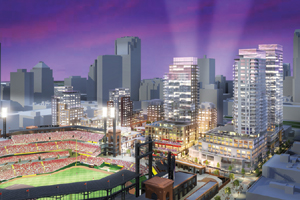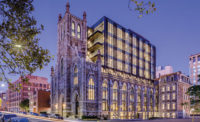Chicago’s Wrigley Field, which for a century has brushed up against apartments, used to be the exception among major-league ballparks, which tend to sit enveloped by asphalt on a city’s fringe. Not anymore. As stadiums move downtown, developers are constructing high-rise residences that offer box-seat-worthy views of games.

In 2004, Antoine Predock Architects’ PetCo Park debuted in San Diego’s East Village, a district once dominated by car-repair shops. Guided by San Diego’s economic development group, Centre City Development Corporation, the neighborhood has since welcomed 3,040 condominium units and apartments, with 5,273 more under way now or in the offing. Opening this fall is the Legend. Designed by Perkins & Company, the 23-story tower contains 183 condo units, many of which command a premium for their sight lines to batters. At its closest point, the building is roughly 100 yards distant from the ball field. Those who don’t have home-plate views—roughly half the units—can still enjoy games from a 2,800-square-foot deck on the seventh floor. The tower’s precast-concrete panels and sandy-colored-brick podium match the aesthetic of PetCo Park and nearby warehouses.
Following the Padres’ lead, the St. Louis Cardinals began work this summer on Ballpark Village, a 9-acre mixed-use development abutting the current Busch Stadium, by HOK Sport, which opened in 2006. The first phase of the $650 million project, designed by Beyer Blinder Belle, will include a 30-story retail, office, and residential tower with 250 condos, many of which will overlook left field. “It may not be for everybody, but for Cardinals fans, it will be the coolest thing in the world,” says Bill DeWitt III, vice president of business development for the team, which partnered with developer Cordish Company on the project.
Developers in Washington, D.C., are hoping the same holds true at the new stadium for the Nationals, which is set to open in time for the 2008 season. Architect Joe Spear, AIA, kept the stadium’s walls low to maximize views from the street. Residents of two proposed condo towers in the surrounding Anacostia neighborhood will also get a view of the action. Even if it means giving away their product for free, Spear says, team owners like next-door neighbors because “if it’s all offices, it will be lifeless after business hours.”
Is a field without players worth a front-row seat? Detroit hopes so. This month it will raze 80 percent of the bleachers that ring Tiger Stadium, which closed in 1999, but leave the diamond intact. Eventually, 300 market-rate condos will surround the grass, says Peter Zeiler, a development representative with the Detroit Economic Growth Corporation, which is orchestrating the project with Hamilton Anderson Associates. “There have been iterations of baseball on that site for 140 years,” Zeiler says. “It’s very sacred ground.” And, many hope, a real estate grand slam.



Post a comment to this article
Report Abusive Comment